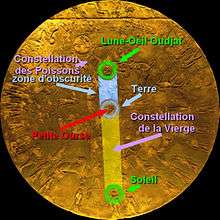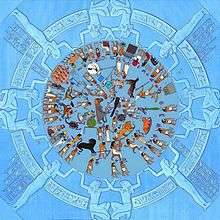Dendera zodiac
Coordinates: 26°8′30″N 32°40′13″E / 26.14167°N 32.67028°E

The sculptured Dendera zodiac (or Denderah zodiac) is a widely known Egyptian bas-relief from the ceiling of the pronaos (or portico) of a chapel dedicated to Osiris in the Hathor temple at Dendera, containing images of Taurus (the bull) and the Libra (the scales). This chapel was begun in the late Ptolemaic period; its pronaos was added by the emperor Tiberius. This led Jean-François Champollion to date the relief correctly to the Greco-Roman period, but most of his contemporaries believed it to be of the New Kingdom. The relief, which John H. Rogers characterised as "the only complete map that we have of an ancient sky",[1] has been conjectured to represent the basis on which later astronomy systems were based.[2] It is now on display at the Musée du Louvre, Paris.
Dates of eclipses

Sylvie Cauville of the Centre for Computer-aided Egyptological Research at Utrecht University and Éric Aubourg dated it to 50 BC through an examination of the configuration it shows of the five planets known to the Egyptians, a configuration that occurs once every thousand years, and the identification of two eclipses.[3]
The solar eclipse indicates the date of March 7, 51 BC: it is represented by a circle containing the goddess Isis holding a baboon (the god Thoth) by the tail.
The lunar eclipse indicates the date of September 25, 52 BC: it is represented by an Eye of Horus locked into a circle.

Description
The zodiac is a planisphere or map of the stars on a plane projection, showing the 12 constellations of the zodiacal band forming 36 decans of ten days each, and the planets. These decans are groups of first-magnitude stars. These were used in the ancient Egyptian calendar, which was based on lunar cycles of around 30 days and on the heliacal rising of the star Sothis (Sirius).
Its representation of the zodiac in circular form is unique in ancient Egyptian art. More typical are the rectangular zodiacs which decorate the same temple's pronaos.

The celestial arch is represented by a disc held up by four pillars of the sky in the form of women, between which are inserted falcon-headed spirits. On the first ring 36 spirits symbolize the 360 days of the Egyptian year.
On an inner circle, one finds constellations, showing the signs of the zodiac. Some of these are represented in the same Greco-Roman iconographic forms as their familiar counterparts (e.g. the Ram, Taurus, Scorpio, and Capricorn, albeit most in odd orientations in comparison to the conventions of ancient Greece[4] and later Arabic-Western developments), whilst others are shown in a more Egyptian form: Aquarius is represented as the flood god Hapy, holding two vases which gush water. Rogers noted the similarities of unfamiliar iconology with the three surviving tablets of a "Seleucid zodiac" and both relating to kudurru, "boundary-stone" representations: in short, Rogers sees the Dendera zodiac as "a complete copy of the Mesopotamian zodiac".[5]

History
During the Napoleonic campaign in Egypt, Vivant Denon drew the circular zodiac, the more widely known one, and the rectangular zodiacs. In 1802, after the Napoleonic expedition, Denon published engravings of the temple ceiling in his Voyage dans la Basse et la Haute Egypte.[6] These elicited a controversy as to the age of the zodiac representation, ranging from tens of thousands to a thousand years to a few hundred, and whether the zodiac was a planisphere or an astrological chart.[7] Sébastien Louis Saulnier, an antique dealer, commissioned Claude Lelorrain to remove the circular zodiac with saws, jacks, scissors and gunpowder.[8] The zodiac ceiling was moved in 1821 to Restoration Paris and, by 1822, was installed by Louis XVIII in the Royal Library (later called the National Library of France). In 1922, the zodiac moved from there to the Louvre.
The "Dendera Affair"
The controversy around the zodiac, called the "Dendera Affair", involved people of the likes of Joseph Fourier (who estimated that the age was 2500 BC).[9] Champollion, among others, believed that it was a religious zodiac. Champollion placed the zodiac in fourth century AD.[10] Georges Cuvier placed the date 123 AD to 147 AD.[11] His discussion of the dating question is an interesting summary of the reasoning as he understood it in the 1820s.
Further reading
- Sébastien Louis Saulnier, Claude Lelorrain, Notice sur le voyage de M. Lelorrain en Égypte at Google Books, Éditions Sétier, 1822.
- Nicolas B. Halma, Examen et explication du zodiaque de Denderah comparé au globe céleste antique d'Alexandrie, Éditions Merlin, 1822.
- J. Chabert, L. D. Ferlus, Mahmoud Saba, Explication du zodiaque de Denderah (Tentyris), Éditions Guiraudet, 1822.
- Charles de Hesse, La pierre zodiacale du Temple de Dendérah, Éditions André Seidelin, 1824.
- Franz Joseph Lauth, Les zodiaques de Denderah, Éditions C. Wolf et Fils, 1865.
- Letronne Antoine-Jean, Analyse critique des représentations zodiacales de Dendéra et d'Esné, Imprimerie Royale, 1855.
- Jean Saint-Martin, Notice sur le zodiaque de Denderah, Éditions C.J. Trouvé, 1822.
- Jean-Baptiste Prosper Jollois; René Édouard de Villiers du Terrage, Recherches sur les bas-reliefs astronomiques des Égyptiens, Carilian-Goeury, 1834.
- Jacques-Joseph Champollion-Figeac, Égypte ancienne, p. PP9, at Google Books, Firmin Didot, 1832.[12]
- Buchwald, Jed Z. et Diane Greco Josefowicz, Le zodiaque de Paris: controverse au sujet d'un artefact égyptien antique qui a suscité un débat moderne entre la science et la religion, Princeton University Press, 2011.
- Éric Aubourg, La date de conception du temple d'Hathor à Dendérah, BIFAO, 1995
- Sylvie Cauville :
- Le temple de Dendérah, IFAO, 1995,
- Le temple d'Isis à Dendéra, BSFE 123, 1992,
- Le zodiaque d'Osiris, Peeters, 1997.
- L'Œil de Ré, Pygmalion, 1999.
- Jean-Baptiste Biot, Recherches sur plusieurs points de l'astronomie égyptienne appliquées aux monuments astronomiques trouvés en Égypte, p. PR3, at Google Books, Firmin Didot, 1823
References
- ↑ John H. Rogers, "Origins of the ancient constellations: I. The Mesopotamian traditions", Journal of the British Astronomical Association 108 (1998) 9–28
- ↑ Zodiac of Dendera, epitome. (Exhibition, Leic. square). J. Haddon, 1825.
- ↑ Marchant, Jo (5 July 2010). "Decoding the ancient Egyptians' stone sky map". New Scientist.
- ↑ As shown for instance in the Almagest.
- ↑ Rogers 1998:10.
- ↑ Abigail Harrison Moore, "Voyage: Dominique-Vivant Denon and the transference of images of Egypt", Art History 25.4 (2002:531–549).
- ↑ Zodiac of Dendera, epitome. (Exhib., Leicester Square). J. Haddon, 1825.
- ↑ https://books.google.com/books?id=2fU-AAAAcAAJ
- ↑ Francis Lister Hawks, The monuments of Egypt: Or, Egypt a witness for the Bible. John Murray, 1850. 256 pages. Page 158
- ↑ https://www.youtube.com/watch?v=jQ4kaFNa8Kc
- ↑ Georges Cuvier A Discourse on the Revolutions of the Surface of the Globe (1825) in the chapter entitled "The astronomical monuments of the Ancients.", pp. 170 and 172.
- ↑ The online book was published in 1839.
External links
| Wikimedia Commons has media related to Dendera zodiac. |
- The Zodiac in the Louvre collections database (French)
- Gyula Priskin, The Dendera zodiacs as narratives of the myth of Osiris, Isis, and the child Horus ENiM 8 (2015), 133-185.